Matador Network's Blog, page 2321
January 22, 2014
BASE jumping Bolivia's Death Road
This from Gravity Bolivia: A rider attempted a mega launch to BASE jump off Bolivia’s Death Road, but fell short and crashed horribly. You can see there’s an instant where he almost gets enough glide to make it out.
Incredibly, even with this gnarly fall, he only suffered fractures to the forearm, cut leg tendons and “a broken arse.” 
A climber’s pilgrimage to Bishop

Annecy, the “Venice of France,” where I ventured into a Patagonia store and saw a photo-poster of the Owens Valley taken by Dan Patitucci that inspired me to make a home in the Eastern Sierra.
Sometimes your life, everything about it — where you live, what you do, who you’ve become — can be traced back to one thing. One moment. One chance encounter.
For me, it was a poster.
It was Christmas time, and I was four months into a year studying abroad in Grenoble, France. My mother had come to visit from California, where I was born and raised, and we were traveling through the French Alps en route to visit a friend in Switzerland for the holidays. My mother has had a life-long love affair with Venice, so of course I had to show her the “Venice” of France: Annecy.
The comparison was a bit of a stretch — there was really only one canal running through town, and the smell was, shall we say, less distinctive. But a beautiful lakeside town nonetheless, encircled by dramatic, jagged peaks. I loved it.
I was told that around four months into my stay, my language skills would plummet suddenly — both French and English — and then my brain would sort of reboot, launching me into the beginnings of fluency. Judging by the looks of confusion my mom would give me at times, I realized this must be true.
But I wasn’t prepared for the lifestyle reboot I was about to receive.
I had always considered myself an adventurer. And as we all know, adventure comes in many marketable brands and logos. So, naturally, I couldn’t just walk past a Patagonia store in the Venice of France. I ventured in.
It was a beautiful building — maple floors, raw wooden beams, pastel walls adorned with shiny Gore-Tex. I found a stairway and followed my curiosity, steps creaking as I left the ground floor behind.
Midway up to the top floor, I passed a poster that caught my attention. A woman was running through golden fields, flanked by spindly leafless trees, purple, snow-crowned mountains presiding over the whole scene. She looked so tiny, in a world of immense natural beauty. This is my next adventure, I want to go there, wherever it is, I thought.

The Dan Patitucci poster
In my travel- and adventure-minded youth, I was sure it must be somewhere exotic and remote, like the Tibetan plateau. I searched the image for the caption. It read: “Salt cedars and grassland. Janine Patitucci on a cool-weather run through Owens Valley, California.”
California?! Honestly.
It was like a smack in the face, a reality check, reminding me, Hey, you live in a beautiful place, too. Don’t forget that.
I had been getting rather avidly into climbing, and while most of my friends made regular pilgrimages to Bishop for the world-famous boulders, I had neglected to join them. But here I was, halfway around the world, and the dream place I saw in this photo took me right back to the land I came from — not further from it, as I had assumed (and maybe even wished) it would.
I am sure this chance encounter with the poster framed my year abroad in ways I still can’t imagine — it certainly shook some sense into my naïve, other-world focus, and may have helped me to remember the wonder of the place I called home. Any time I failed to deflect political flack from my French peers, I could easily distract them with awkward assortments of French adjectives describing la Californie, a place with wide open spaces and purple mountains.
Fast forward to the next fall. I was finally driving to Bishop, linking up with the annual climber’s migration route from the mountains to the desert. One of my friends had been there several times, and had the local scene dialed. We pitched our tents at The Pit and headed to Schat’s Bakkerÿ in the morning. Fresh-baked bread and flaky croissants hearkened back to my year in France. I was in love before we’d even hit the boulders.
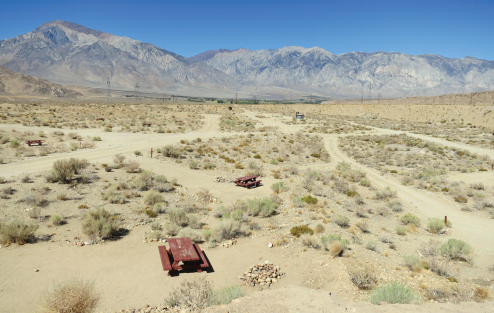
The Pit. Photo: Author
The next morning, we awoke to a dusting of snow on the White Mountains. There I was, in the poster.
The following spring, I was preparing to graduate, clueless as to my next move. I got an email advertising a position as a backcountry field tech for the White Mountain Research Station. It was a seasonal job, based in Bishop, and involved spending most of the summer in the mountains collecting bugs from alpine meadows: Extensive backcountry leadership experience ideal, and familiarity with benthic invertebrates preferred, the email read. From my random smattering of college jobs, wilderness leadership and microscopic bugs in the mud happened to be the strongest themes on my resume. I couldn’t help but think it was meant to be.
I contacted the lead scientist, sent my resume, and before I knew it I was driving to visit the research station — and go backcountry skiing to get to know my new boss.
Is this for real?
After the summer job ended, I knew I wanted to stay on the Eastside. I found a job driving buses for Mammoth Mountain, and a room to rent near Bishop. The poster still haunted me, and I wanted to find a copy of it.
I contacted Patagonia, wrote them my story and asked if they knew where I could find a copy. They got right back to me, and sent me a jpeg file — it fit the description perfectly, but it was definitely not the one I remembered. The marketing guy from Patagonia informed me that the Patituccis did a lot of photography for them, so I might contact them directly.
I found their email and wrote them my story, expressing how, in wandering retrospect, this photo changed my life. Dan Patitucci sent me a very warm and appreciative email. He knew exactly which photo I meant. He was in Italy, but he connected me with Janine, who was going to be in Bishop soon. She asked if I could meet her for coffee.
I arrived early at the Black Sheep Café, oddly nervous. I didn’t know many people yet, and had a feeling I was meeting with someone very prominent in the community. Janine walked in with a large roll of paper under her arm. She was just visiting for a month or so, but was glad we could meet — she had something for me.
I unrolled it, and there it was — the impetus, the beacon that brought me from the European Alps back to my home state, into a world of adventure and discovery that had always been right in my backyard. I could feel my eyes welling up, and tried not to smile too broadly, for fear that my scrunched cheeks would squeeze out a tear in front of someone I had only just met.
I thanked her, and we chatted for a while about the Eastside and the Alps.
I have never considered myself a fatalist, nor have I necessarily subscribed to a belief in destiny, but sometimes, looking back at the events in life and tracing back to one encounter that completely and permanently altered everything you are, defined who you’ve become — it’s hard not to wonder.
Some years ago, while milling about in a conference room before an orientation for my first mountain guiding job, a quote by Rumi on the wall caught my eye: “Let yourself be silently drawn by the stronger pull of what you really love.”
Wide open spaces and purple mountains. ![]()
Bishop bouldering betaNo Bishop bouldering trip would even start without a visit to Wilson’s Eastside Sports. It’s the best spot in town for any gear, guidebooks, and great local info from the guys and gals behind the counter. In the past few years, a couple of other stores have made a home on Main Street, and complemented Bishop’s outdoor store scene tremendously: check out Mammoth Gear just next door to Wilson’s, a consignment outdoor gear shop with great deals on new and used gear; and just across the street you’ll find Sage to Summit, primarily geared towards mountain runners but with a very thoughtful assortment of items.
Camping is ubiquitous in the Bishop area, with The Pit being the main climber’s campground. The campground is not much, as the name suggests, but it does have restrooms and it’s hard to complain at only $2 per vehicle per night (though the view of the mountains is quite spectacular). Other camping options exist, just ask one of the local climbers who came and forgot to leave.
In the morning, when the warmth of the sun chases you out of your sleeping bag and the crisp morning air wakens your senses, skip the coffee in camp and head into town for fresh pastries, a hearty breakfast sandwich, and a cuppa locally roasted joe. The Great Basin Bakery has croissants of which even the proudest French enthusiastically approve (I’ve checked), as well as outstanding bagels, baked goods, sandwiches, and soups. Schat’s Bakkerÿ is a longtime climber’s go-to, with great danishes and other baked goods. For a mellow start to your morning, and to key into the local climbing scene, check out the Black Sheep Espresso Bar on Main Street. Finally, as the days shorten and the evening chill sets in, the Looney Bean is a good spot to catch up on your blog, or just enjoy the great indoors.
The 25 worst passwords of 2013
So…which one of these do you use?

Source: SplashData
This list is from SplashData, who compile it annually. This year’s was influenced by the massive Adobe security breach — in which from anywhere between 38 and 150 million people were affected — last October, which you can see by the inclusion of software-specific passwords like “adobe123.”
It’s getting near impossible to keep track of the numerous passwords most of us have. When are we going to finally see retina scanning? 
What journalists carry: Lucas Pernin

Beni Zeid, Aleppo. The insecurity of daily life as the indiscriminate bombing and shelling continues makes even buying bread a lottery. The bakery took three direct hits, and even though the neighborhood was under continuous bombing, people had no choice but to wait in line. Lucas Pernin
Matador is teaming up with the FFR1 to show you what conflict and foreign freelancers carry with them on assignments.
I’M A freelance photographer and writer based in Sweden. I primarily work in the Middle East and most recently focused on the conflict in Syria. I work mainly for Scandinavian magazines and weeklies, but occasionally I write for publications in Europe and South Asia.
I received an MA with distinction at Westminster University where I studied photojournalism. I also earned a BA in Human Geography from Lund University. My professional focus is on long-form storytelling, where I develop detailed, episodic narratives of human interest stories in conflict or troubled areas. My work has been on exhibit at the Foto8 Summershow and Nepal Art Centre.
This was my bag for working in Syria. Less is more. I take that saying wherever I go. I travel light, and over the years realized that for the photography I’m interested in making, there’s no need for more than what I have. My legs are my zoom, and keeping a light pack makes it easier to move around when needed. Of course the equipment might get broken or stolen and I don’t have an extra body on the inside, so I keep an extra on the border.
My one tip would be that baby wipes are the best thing for this type of work, perfect for cleaning when there is no water. Whatever equipment you have is great, but without research beforehand and proper preparation, it won’t mean much.
View more of Pernin’s work on his site.
In the bag
Canon 5D Mark II
Canon 50mm 1.4
Canon 28mm 1.8
2 extra batteries for the 5D plus charger
Memory cards (lots of them)
MacBook Pro 15″
Laptop case (waterproof)
Portable hard drive USB drive (no external electricity needed)
Notebooks (Moleskin, several of them, but not the bulky ones, the ones that fit in the back pocket)
Pens, VBall (Well guess I got issues since I only like using one kind)
Audio recorder (USB transfer)
Card reader
Cleaning equipment for the camera (blower, swipe, etc)
Cheap Nokia phone where the batteries last forever
Elastic electrical tape
Several USBs
The bag is a Fjällräven 30L with two great side pockets for easy access. Reinforced bottom so that it doesn’t soak up the humidity. Plus I take the padding from another camera case and put it in the bottom.
Not in photo
Food – Power bars, dried food packages
Cigarettes, lighters (for some reason lighters keep disappearing)
Med kit – plus body function pills
Flashlight plus headlight
Baby wipes – great for hygiene
And of course all the electrical cables needed to plug in the equipment 
1The Frontline Freelance Register (FFR) is a representative body for freelancers, created and run by freelancers. It is an independent, ring-fenced entity which sits within the Frontline Club Charitable Trust with membership open to all freelance journalists working in conflict or foreign reporting. The FFR’s core objective is to support the physical and mental well-being of freelance journalists. In a world where staff jobs and fully paid foreign assignments are increasingly scarce, foreign and war reporting is dominated by freelancers, many of whom are deeply committed professionals doing outstanding work. At the same time, many of these freelancers lack the institutional support and the financial means to adequately manage the challenges of operating in dangerous environments in the long term. They also lack organised representation, often leaving them at the mercy of powerful media groups. FFR aims to help freelancers by providing them with a forum, a representative body, and a critical mass to face some of these challenges.
Evolution of the bobsleigh [vid]
I’LL BE honest. I don’t find bobsledding to be the most exciting event at the Winter Olympics. It is, though, impressive to stand there and see this blur whip by you at 90 mph, and the excitement of just being in an Olympics crowd is palpable. I was fortunate to attend some events at the 2010 games in Vancouver, including some bobsledding at Whistler.
What I do find interesting is history, and I love this look back at how this event has changed since 1924, from woolies to spandex bodysuits, and open sleds to lightweight composite speed machines. I particularly liked the steering wheel shown in 1932 at Lake Placid. Bad ass. 
24 hours at the Pushkar Camel Fair
During the holy month of Kartika, the devout descend on the town of Pushkar in Rajasthan, said to be the spot where Lord Brahma dropped a lotus flower to form the lake around which the town is built. Tens of thousands of believers come to bathe in Pushkar Lake, more and more each day as the full moon, the holiest day, approaches.
Simultaneously, tourists descend on the town for the Pushkar Camel Fair, a concurrent event that’s one of the largest livestock fairs in the world. If you get there early you can watch camels arrive in streams over the horizon, tens of thousands of them. Tent cities pop up around the fairgrounds for the herders and their families. There’s an arena for events, which run all week long, and several Ferris wheels are erected. The dusty streets leading into Pushkar are lined with stalls selling everything from precious cashmere to camel decorations.
The sacred movement of over 50,000 bathers is pushed right up against the seemingly outlandish spectacle of 50,000 camels, and for two weeks Pushkar expands to nearly 200,000 people. Here’s what one of my days at last year’s fair looked like.
 This post is sponsored by SanDisk. Click through to read more of life’s stories, told from memory.
This post is sponsored by SanDisk. Click through to read more of life’s stories, told from memory.
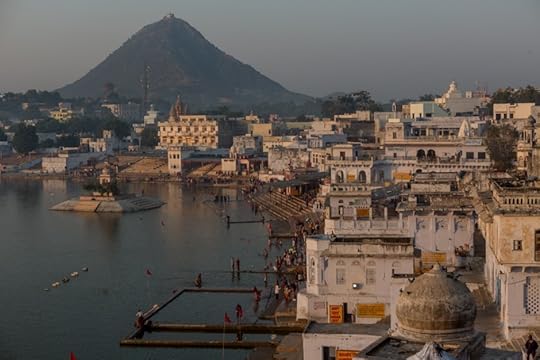
1
Pushkar
Devout Hindus take to the lake at dawn, while the city soaks in the warm, orange light of the rising sun. There are 52 bathing ghats in Pushkar, and while it's not permitted to photograph the bathers, it's impossible to get a shot of the town without at least a few in there.
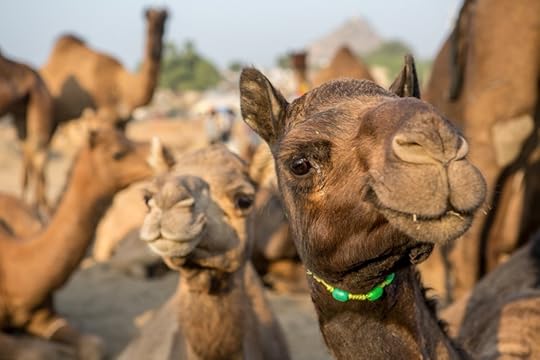
2
Focus
At 6:30am, visiting photographers are out in full force to capture the morning light. I see Nat Geo media tags, big-shots with assistants, and more coveted "beige" lenses and mammoth zooms than a Canon convention. Many of the herders are trying to dodge cameras while going about their morning business. I decide to focus only on the camels until I can crack a smile from a herder.

3
An open door
It works. Not only do I manage to make these two giggle—by laughing at myself when I step in one of the many mounds of camel dung—but when they're done shaking their heads at me, they immediately ask me to take their photo with a prize camel.

More: 8 lessons you learn in Patagonia

4
Morning chai
And just like that I'm welcomed for morning chai and breakfast. For the most part I put my camera to rest and enjoy watching the fairgrounds wake up—sitting by a warm fire, eating freshly made fire-roasted chapati, sipping on chai, and being scolded for my tattoos.

5
Bartering
The buying and selling of camels is the central purpose of the fair, and it’s not lost in the mix. Herders—all men—wander through the throngs of camels, checking everything from hooves, to gait, to teeth. What they barter about, I could not tell you, but it was mesmerizing to watch.

6
A closer look
This fellow is deciding how he feels about this particular camel. The animal has a foot injury, but it's just a baby, full of potential, and is being offered at a good price. Pushkar window shopping.

7
Wanderer
Holy men wander both the lake and the fairgrounds, carrying small tins to accept donations. They're referred to as sadhus or, more fondly, babas. Sadhu life is a hard one: They cut family ties and devote themselves to their faith, traveling in pilgrimage from city to city to the end of their days.

8
Afternoon crowds
I take a long break during oppressive afternoon heat to drink fresh lassi (yogurt) and rest. While the fairgrounds are wide open, the ancient streets of Pushkar are narrow and winding. With so many people, it’s literally shoulder-to-shoulder, and intersections sometimes come to a standstill.
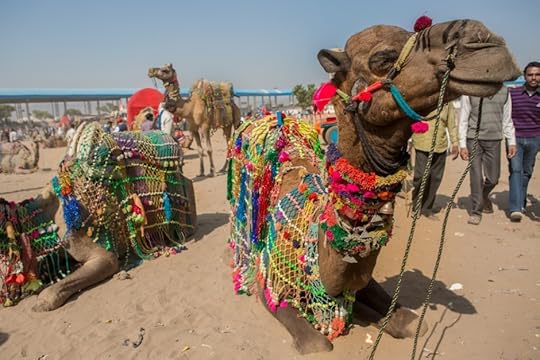
9
Decorated
After hanging out on my hotel's open veranda, which looks over the lake, I decide the heat of the day has mostly passed and head back to the fairgrounds for sunset. En route, I stop at the Pushkar Arena, where one finds the camel decorating contests, mustache contests, and other events.
Intermission

Photo essay: Light and shadow in Chiang Mai, Thailand
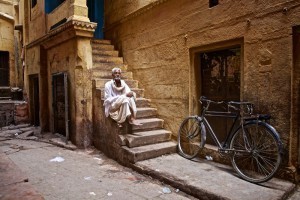
Notes from a photographer in Varanasi, India
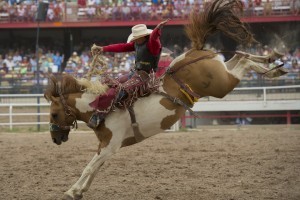
Photographing the world’s largest outdoor rodeo

10
Caravan ride
Caravans pull tourists through the fairgrounds. I'm envious of this shady, restful mode of transport, but I feel the grounds are best experienced on foot. If I'd not been on foot, I never would have had breakfast with camel herders at dawn or shared their traditional pipes at dusk.

11
Packing up
The sun lowers on the horizon, and the herders begin to pack up their camels and spread out for the night. Some leave all together if their business has been accomplished. All across the fairgrounds, smoke spirals into the hazy orange sky as herders and their families begin tending to dinner.

12
Dusk
Dusk arrives and the sun droops further. The sky stays pink for a long time. Everything feels still.
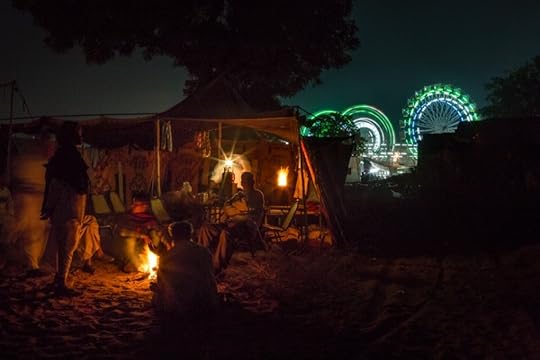
13
Tent city
Families gather around their fires in the tent city, a low murmur of Hindi, Punjabi, and other dialects. Fires hiss and crackle, while vagabond sparks whirl through the night air, which has grown cold. Behind this family, the Ferris wheels turn late into the night.

14
Fire twirler
Pushkar does anything but sleep. Restaurants are full of tourists; the narrow streets teem with Indian families buying deep-fried sweets and samosas; others take to the fairgrounds for the Ferris wheels or to purchase new bangles, brightly colored saris, or ornate, hand-woven rugs. Holy men and devout Hindus burst into song, dancing and drumming up and down the alleyways. Here, a fire twirler from a gypsy troop performs for tourists outside the city.

15
Lone camel
A lone camel stands in the moonlight. It's late, and there are no other sounds. I'm amazed at how far I can see. While the devout bathe in Pushkar Lake, I lie back and bathe in the moonlight.
8 challenges for today's ESL teacher

Photo: Renato Ganoza
1. Contracts
What sometimes happens:
a. You fly into a new country on a one-way ticket and are expecting to find someone waiting for you at the airport to take you to your single apartment for a few days off before starting a trial period with the outgoing teacher. Instead, you’re left standing by baggage claim and have to navigate public transportation to discover you have a messy, noisy roommate and you’ll be teaching your own classes, sans training, the following day.
b. You’ve asked for permission to take a few days’ off over the Christmas holiday and decide to go to the Philippines. Two days before you’re set to leave, your manager informs you you need to desk-warm (stay in the school when no students or other employees are around) during your vacation time.
c. You haven’t been paid for two months, and it’s looking like your academy is going out of business.
How you should handle it:
a. To minimize the chance you’ll be placed in a very uncomfortable working situation abroad, you need to prepare. During your initial interview, ask to speak to other foreign teachers. Ask for pictures of your apartment and confirm you’ll be living alone. Research the school’s reputation for being honest. If anything is different upon arrival, decide whether you want to suck it up or walk away. It’s your choice.
b. Although having vacations moved or cancelled is a possibility in any company, desk-warming is usually limited to teachers working in public schools in South Korea. As a foreign employee, you’re given a set amount of days off every year. However, these do not necessarily coincide with those holidays Korean teachers are given. As a result, teachers are expected to sit at their desk when everyone else is on holiday; often, this is during the winter and the heat isn’t turned on.
I’d recommend standing your ground or walking away, but some enjoy the opportunity to just relax and use Facebook under the guise of working. When other teachers have been told they have to go to an empty building and sit at a desk when they’ve already paid for non-refundable plane tickets and hotels, they sometimes just take all their belongings with them and keep traveling.
c. Depending on the situation, you may have legal avenues to pursue. Are you working on a legal visa? Do you have a contact in the local labor board? Any leverage with your manager? Many disreputable schools take advantage of fresh recruits with little knowledge of the system available to them. If you’re unprepared for a fight, you might have to cut your losses.
2. Dealing with precedents set by other teachers
Despite ESL seeming to be a well-established profession across the world, most countries are still figuring out how to handle foreign language instructors permeating their working culture. If one teacher from 1984 created problems or established a weird precedent, you’re going to be paying for it in some manner.
Case in point: Two NOVA teachers in Japan were arrested for possession of marijuana back in 2006. There are now regular seminars denouncing drug use and employees are interrogated often. In Korea, you may have to take a blood test when starting or renewing contracts.
How you should handle it:
Lead by example. You may not be able to change the system in your year abroad, but by doing a job well with little incident, you show your managers and coworkers not all foreign language teachers are late, boozing, sex-crazed, immature louts just trying to stay out of their parents’ basements.
3. Bad managers
Bad managers are everywhere. Cultural differences and the stress of living in a foreign country only exacerbate this when you have one.
How you should handle it:
If it’s simply a matter of your manager being an evil human being, there’s very little to be done. However, if it’s a case of misunderstandings or cultural differences, the burden is on you to remedy the situation. Remember, you are the guest in a different country. See if you’ve done anything to accidentally offend your boss. Study up on local customs to see if you can make a good second first impression.
4. Culture shock
No one can be fully integrated into a different culture, as much as we might want to be at times. There’s always going to be a trigger, a moment that makes you realize how far from home you truly are, and how long it will be before you can get back.
How you should handle it:
Use teaching as your own learning experience. Though this may sound like you’re taking advantage of students, I’d describe it as a symbiotic relationship; you get to teach them something about your country and language, and vice versa. The difference is, while they may never reap the benefits of your knowledge, you can use theirs immediately.
Take some time each month, once a week, or maybe every day to have a homesick moment. For me, this means eating pizza and watching the Daily Show. Whatever comforts you can find, save them for when you know you’ll need a break.
5. English immersion
The main reason you’re going to be hired as an English teacher is to fully immerse students in the language. This means none of their native language escaping your lips at any time for any reason. In some cases, you’ll actually be contractually obligated to only speak English and can be reprimanded for not doing so.
What this means for you as a teacher is dependent on your students and coworkers. If you’re teaching children, you’ll have to establish your authority early on to try and maintain order… for kindergarteners and younger ones, this is next to impossible solely using English. Even with older children who have a little more restraint and respect, you should expect the occasional insult and laugh at your expense.
Not knowing the language also means limited communication with coworkers and parents, and the risk of you losing control of your reputation. Even in foreign countries, some things like office politics are exactly the same. Some teachers won’t like the fact you get special treatment as a foreigner; in Japan, you’re paid significantly more and are able to use your holidays.
How you should handle it:
In my experience, the key to handling children you can’t understand is to simply break the rules and learn enough of their language to insert the right command when the situation calls for it — i.e., “sit down, be quiet, read, don’t swear.” If you can convince them you understand what they’re saying, but simply choose not to speak their language, I would consider that a small success. It’s not really necessary when schooling adults.
6. Accepting your experience and professionalism often mean nothing
The ESL profession across the globe is lacking standards. In Peru, backpackers of any nationality (who can speak English) can just walk into a private academy and expect to get a job. TEFL certification is only required at some schools in Thailand. Even the United Arab Emirates has gotten on the bandwagon of “hire first, deal with incompetency later.”
The reason for this, I believe, is two-fold: 1) Many schools want new, naïve teachers who have no knowledge of the industry and little experience in the working world so they can be easily manipulated and controlled. Call me a conspiracy nut if you like, but the fact remains the ESL profession outside of universities is dominated by young 20-somethings, most of whom are enjoying their first time out of their home countries. If recruiters and schools really cared about bringing in qualified and experienced teachers, why not hire 40-, 50-, and 60-year-olds who have decades in the classroom? Because, 2) Keeping the workforce young and fresh keeps costs down by not requiring raises, benefits, and pensions; a 20-year veteran of teaching English in Canada would make an excellent addition to the staff at Disney English in China, but you might actually have to pay her what she’s worth.
How you should handle it:
Accept your place in the system. Getting frustrated or trying to fight the man is futile. Just smile and enjoy the ride; you’re still having an amazing experience.
7. Lack of student inhibitions
One of the difficulties in being a teacher in any subject is the desire to be close to students while still maintaining a barrier of professionalism in the classroom. You want to be friendly, but not so much that they think they can goof off and avoid the lesson. If this barrier is shattered, it can amount to rather personal questions like, “Are you married?” and “How much money do you make?” ESL students in Asia have been known to be rather physical by American standards (just google “kancho”), pulling on arm hair and pinching and touching teachers.
How you should handle it:
Establish boundaries early on. The key in any ESL program is being an edutainer: entertaining enough to engage students, but professional enough to ensure they still learn. When confronted with the idea that something is perfectly acceptable according to local culture, stand your ground and admit you’re open to new experiences, but some things are too much.
8. Being the outsider
What gets to me are the stares, and the meaning behind them. Namely, that this creature at the head of the classroom is different than anything I’ve encountered before, and I’m not sure whether I should listen to it or ignore it and maybe it will go away on its own. Next are the questions — can you use chopsticks, can you eat kimchi — and the assumptions (“Don’t all Americans own guns and smoke?”). It was part of the reason I eventually left Japan, believing I could never get past this mentality of the eternal tourist.
Learning just how racist some of my students could be didn’t help matters. I understood this was due to lack of exposure to other races and cultures, but I personally found it to be frustrating. One university-educated woman in Peru stretched her eyes when talking about Asians and refused to believe Japanese and Chinese were that different. One Korean girl opened her mouth and used her hand to make a native American war cry. I’ve heard from many African Americans that schools often refuse to even consider their applications when they discover they’re black.
How you should handle it:
Again, lead by example. Like it or not, you are a representative of your country, your race, and your gender, and you will become increasingly aware of that as the months pass by. Realize that these assumptions come from ignorance, and try to teach your students otherwise; I’m not saying it won’t be difficult, but even challenging these falsehoods is progress. ![]()
January 21, 2014
How to enjoy marijuana in Colorado

Photo: Jonathan Piccolo
My hotel room is non-smoking. So is every restaurant and bar in Colorado. So are the ski areas. Wait, what? I was promised pot tourism and legal marijuana!
Such might be the thoughts of every tourist who hits the Centennial State. Yes, you can smoke pot in the privacy of your own home, but what if you don’t have a home here? Quandary. You need a different way to enjoy Colorado’s legal marijuana, one that won’t incur you a $200 cleaning fee because you didn’t score one of the five smoking rooms at the Vail Holiday Inn (5% of the entire hotel). You need some recreational marijuana smoke-free options.
There are two ways to go: vaporizers and edibles.
Vaporizers

Pen vaporizers. Image courtesy of Ploom.com
Vaporizers are the best alternative to lighting up. Pen vaporizers are discreet, easy to carry, and — most importantly — vaporizing marijuana is 95% smoke and carcinogen free. See, health benefits!
A vape pen will cost you around $100 for a quality product, but that’s still cheaper than a hotel room fine and a lift ticket. (Although there’s always the light bulb…) These are some of the best vape pens:
Open Vape — Colorado-based and readily available, folks. The kit uses separately sold cannabis oil cartridges, the atomizer has a special honey oil, and it comes with a lifetime warranty.
Pax by Ploom — Industry agrees this is a top of the line vape. Adjustable heat settings, barely 4″ long, and it comes with a wall charger. It’s basically a pot iPod.
AtmosRX — Won first place in The High Times Vaporizer Pen Buyer’s Guide. Junior options (a bit cheaper) for those who want a smaller pen and an advanced option for those who care just a bit more.
Reddit Pineapple Laser Launch Kit — In honor of the r/trees community on Reddit, Magic Flight presents this vaporizer that comes in three different types of finely polished wood. It’s also handmade in the USA — buy local.
Silver Surfer — If you’re an artiste as well as a viper, you might want to shell out for the surfer. The temperature adjustment knob is custom handblown glass with a matching (if you want) glass marble pick.
Edibles

Image courtesy of Cheeba Chews – Facebook.com
If you just don’t want any part of inhaling, then you get to go gourmet. Marijuana edibles are the way to go — just stash them in your mini-fridge out of the tykes’ sight and partake when you get back from the hill.
Cheeba Chews — There’s a reason these chocolate taffys are a two-time Cannabis Cup winner. They are incredibly delicious and they give the THC plenty of TLC — they’re still made by hand.
Dixie Elixirs — The “future of cannabis,” they say. Pro tip: Any weed treat that sounds as epic as the Fountain of Youth is worth your money. Elixirs come in sarsaparilla, pomegranate, and other fruit flavors; they also make edibles.
Twirling Hippy — Bakery of sweets. Enough said. Go for the handmade chocolates, savory cashews, or the cheesecake cups — or order a 9″ cheesecake if it’s someone’s birthday. Just make sure when you get the munchies you don’t eat another one of these by accident.
CannaButter — For the bakers among you, don’t bother messing up sticks of butter while you try and find the perfect cannabis concoction. Pick up a tub of pre-made CannaButter and just get to the fun stuff.
Get more info on legal pot in Colorado, as well as the best activities and events across the Western US and Canada, at MountainHop. [image error]

Beijing's crazy air pollution [vid]
My idea of a fun vacation does not involve wearing a medical mask, and being told to stay indoors during specific times of day. I can’t believe how Beijing is so affected by air pollution, that the city looks like it is covered in fog – except this fog is thick, stinky, and hazardous to your health.
The smog is a result of coal emissions from factories within the city; LED billboards in Tiananmen Square have even begun playing videos of sunrises. While these videos are promotional tools advertising the “beauty” of China, for many locals, that’s about as majestic as Beijing is going to get for now.
Read more at the Daily Mail.

When every place seems the same

Photo: Chris Ford
It is midnight on Mindil Beach in Darwin, Australia. The air is hot and wet and carries the salt reek of the sea. Backpackers sit scattered on the floor of the parking lot outside their vans rolling cigarettes and giving each other massages.
On this clear but moonless night the surrounding mangroves and palms are barely shadows, but we know them well; many of the backpackers sleep in them every night, as well as in caves or tents or under trees. One French guy, Marco, is so at home he has even started growing his own vegetable garden. The soft yellow lights of the parking lot are weak but allow enough light for a lazy game of hacky sack on the road. I am chatting with friends and watching the players when out of the darkness two Aboriginal fellas approach.
“Hey, hey, you got a light?” the first guy says gruffly, while his friend sways behind him. They wear t-shirts, shorts, and no shoes. I pass him the lighter and he lights his cigarette. “Where are you all from?” he asks.
“South Africa,” I say. The fella’s eyes light up. “Africa? Respect!” I laugh and give him a fist bump.
“Where are you from?” I ask.
“Arnhem Land, ya ya, I come from bush. I’ve come to see my missus. I have a missus here in Darwin and a couple of kids… a white missus.” He smiles knowingly. My friends and I nod silently.
“Ya ya, a white missus. But we got problems you know, we fight a lot. I never stay long, ha ha.” His cigarette goes out and he asks again for the lighter.
“Ya, I just come up from Arnhem Land you know and then I go back.” His friend wants to leave and pulls on his arm but the smoker ignores him.
I have heard these recycled conversations before and I begin to feel bored.
I look at the two guys. Traveling a year through Australia — from Melbourne through Sydney up to Brisbane — I have barely seen any Aboriginals — until I landed in Darwin. For some reason, I haven’t pursued conversations or prolonged the interactions. Deep down I would like to find out more about them, where they come from exactly and what they do, but I don’t. Instead of reaching out, I surprise myself with how I casually brush them off. Where is that old curious spirit that used to revel in these situations? I seem to have lost interest and I wonder if, after a period of long-term travel, I’ve become jaded.
The two men decide to keep moving. As they wander off, my focus returns to the familiar sight of the backpackers being backpackers. I drift over to them and overhear a chat about finding farm work in Queensland and a story about the full moon party in Thailand. I have heard these recycled conversations before and I begin to feel bored.
Alex Garland wrote about this type of malaise in The Beach. He observed that we might go travelling to find something different, but we always wind up doing the same damn thing. I walk away from the group into the semi-darkness of the tropical night and lean against a palm tree. If travelling is about new experiences, then why do I keep on hanging around with the same people, talking about the same things? Continuously travelling with other backpackers means I only ever really experience that one community. As much as I love it, it sometimes seems all too familiar, a little too easy.
I seem to have fallen into a travel rut and con myself with thinking that I am brave and adventurous purely because I am travelling. The truth, however, is that I have allowed myself to be sucked into a comfortable on-the-road routine and am not really breaking out from the cocoon of backpacker life. It is so easy to aimlessly wander and plod along when you have the right company. That, I inconveniently admit to myself, is not the point. The challenge is to be our own pioneers, for each day to encounter new and changing faces under a new and changing sun.
As I watch the two guys falter along under the dim lights of the parking lot, I think for a second that maybe I should follow them and join them on their mission, whatever that is. I could see and experience something completely novel, a real adventure. I could break out of my safe existence and try something new. I could possibly learn more than what I think I know about Aboriginals and move past my limited ideas. Instead, I retreat back to my friends and to that stale feeling of few surprises, to the very same familiarity I once found so unbearable that it spurred me to travel in the first place. [image error]

Matador Network's Blog
- Matador Network's profile
- 6 followers






